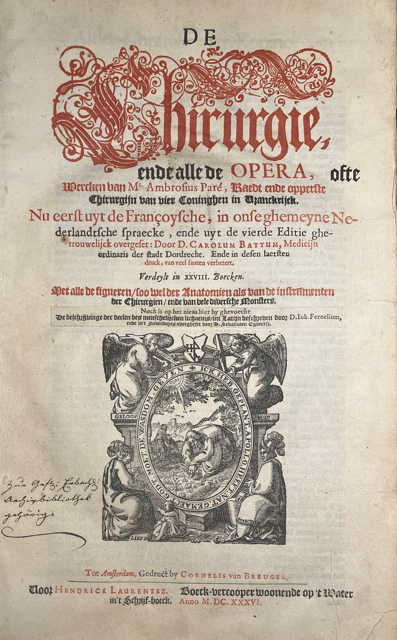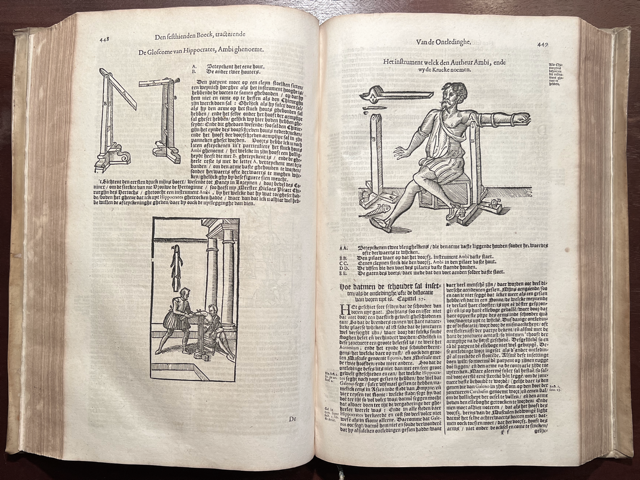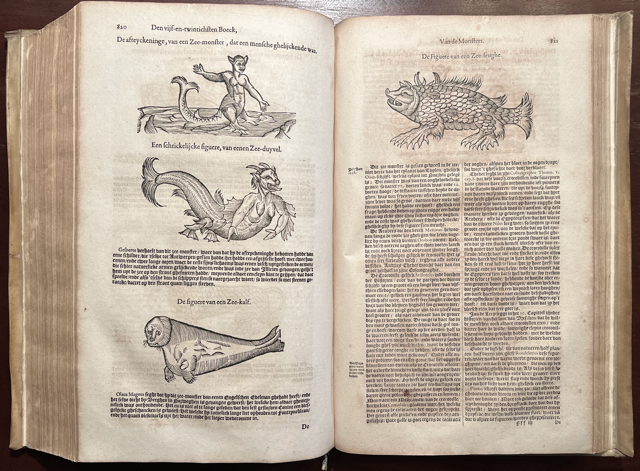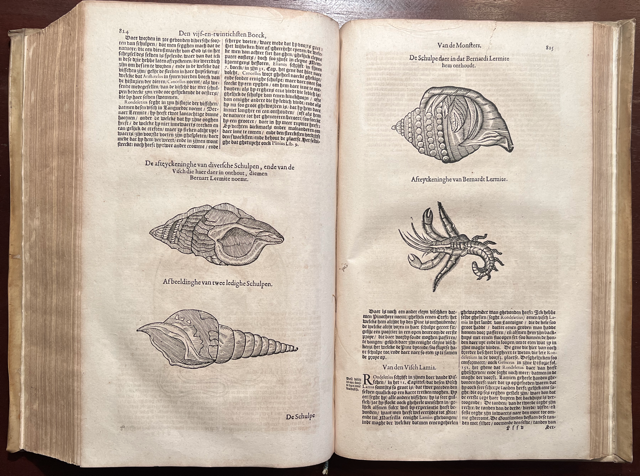
Antiquarenbeurs Mechelen
Deelnemer
Florisatus Fine BooksPlein 19 C
2511 CS Den Haag
Netherlands
Contact
Edwin & Liesbeth BloemsaatTelefoon
+31 (0) 614 270 027 +31 (0) 614 270 027Website
ilab.org/affiliate/florisatus-fine-books-manuscripts-musicalia
Ambroise Paré's founding work on surgery
De chirurgie ende alle de opera, ofte wercken. Nu eerst uyt de Françoysche, in onse ghemeyne Nederlandtsche spraecke, ende uyt de vierde editie ghetrouwelijck overgeset: door D. Carolum Battum. Ende in dese laetsten druck van vele fauten verbetert. Verdeylt in XXVIII. Boecken. Met alle de figueren, soo wel der anatomien als van de instrumenten der chirurgien, ende van vele diversche monsters.
[On a glued on printed paper slip:] Noch is op het nieus hier by ghevoecht De beschrijvinghe der deelen des menschelijcken lichaems, int Latijn beschreven door D. Ioh. Fernelium, ende in 't Nederduyts overgheset door D. Sebastiaen Egbertsz.
Amsterdam, gedruct by Cornelis van Breugel, voor Hendrick Laurentsz, 1636. Folio (380 x 225 mm). [XVI], 940, [12]; 42, [2] p.
With a large woodcut printer's mark on the title page, and ca 340 woodcuts from the same blocks as those of the 1592 edition in the text. Title page printed in red and black.
Vellum laced case binding with yapp edges. Title in ink at the head of the spine. This is the 5th Dutch edition of the collected works. [Preceded by the 1592, 1604, 1615, 1627]. In fact a page for page reprint of the 1604 edition. Issued with it, is Jean Fernel's' Beschrijvinghe der Deelen, which appears only together with the 1636 edition. This tranlation is based on the 4th French edition, wich was the last by the author himself.
Inside we find a wonderful array of woodcut textillustrations depicting surgical instruments, many of which designed by Paré, woodcuts of surgical operations, woodcuts of every major internal organ (Including the brain, the eyes, urinary tract etc.), depictions of the uterus and childbirth, teratology, beautiful illustrations of artificial limbs, plastic surgery, distillation apparatus and a rich amount of natural history illustrations (Book 25 on the Monsters) including whales, sea lions, birds of paradise, bats, etc.
Ambroise Paré (1509-1590) was a French barber-surgeon. He went to war serving several masters, and so gained a lot of practical experience with gunshot wounds. He was the first one to cure wounds with a mixture of i.a. terebinth, which proved to be much more effective than stopping the bleeding with boiling oil. He also invented many new surgical instruments, devised new methods in dentistry for extracting teeth, filling cavities, and making artificial dentures. He describes an artificial hand from iron, and also artificial noses and eyes of gold and silver. He built a good reputation and was appointed as the king's surgeon in 1574. His first collected works appeared in 1575 in a single folio edition. Paré left a powerfully reactivated surgical tradition at his death.
Not only in Europe Paré's work played a major roll in surgery, but also in Japan he was virtually the only source for later generations of physicians. Sometime after 1650 the introduction of European surgery into Japan was by means of a Dutch edition of Ambroise Paré's De Chirurgie, which had been brought to Nagasaki by an unknown Dutch physician. That particular book was the object of much curiosity on the part of the Japanese physicians who chanced to see it.[ This (1649) copy ended up in the University library of Tokyo where it was unfortunately destroyed in the earthquake of 1923] At the hands of Eikyû Narabayashi, Paré's De chirurgie was abstracted into the Japanese language in a manuscript work known as the Geka Soden or as the Geka Soden kinso tetsuboku-bu or as the Oranda geka soden. After Paré method even a surgery school was founded, the Seikotsu Jitsu.
-Provenance: Old german provenance; Ex libris of N. Speijer. Nico Speijer (1905-1981) phsychiatrist; Ex libris of "E. Grendel". Elize Grendel (1899-1986) was pharmacist and historian in Gouda.
-Literature: Doe, A Bibliography of the works of Paré, no 62 , p 197-198; DSB X, p. 315-317; Kleiweg de Zwaan, Die Heilkunde der Chinesen und Japaner, p. 62-63; Numato Jiro, Western Learning, [1992], p. 22-23; Hirsch/Hübotter IV, p. 502-504; G&M, comp. 5556 (ed. 1575); BMN vol. I, p. 288; Not in Waller, comp. vol. I p. 319; Not in Krivatsy, comp. 8599-8602; Not in Cushing Coll. comp. P65, 66; Not in Wellcome, comp. p. 295; Comp. Lilly Library, p. 46-47; Wangensteen, pp. 4-5, 451; Gurlt II, p. 688-785: Garrison, History, p. 224-226; C.L.W.Rogge, De betekenis van Ambroise Paré'[1973, thesis Groningen].
-Condition: Occasionally a few lvs. some light to medium browning; p. 769 a diagonal tear [ca 14 cm] repaired w. old transparent tape, affecting the surface of the paper; A small clear cut to lower part of spine, 2 cm.; A very good copy in an original full vellum binding.
With a large woodcut printer's mark on the title page, and ca 340 woodcuts from the same blocks as those of the 1592 edition in the text. Title page printed in red and black.
Vellum laced case binding with yapp edges. Title in ink at the head of the spine. This is the 5th Dutch edition of the collected works. [Preceded by the 1592, 1604, 1615, 1627]. In fact a page for page reprint of the 1604 edition. Issued with it, is Jean Fernel's' Beschrijvinghe der Deelen, which appears only together with the 1636 edition. This tranlation is based on the 4th French edition, wich was the last by the author himself.
Inside we find a wonderful array of woodcut textillustrations depicting surgical instruments, many of which designed by Paré, woodcuts of surgical operations, woodcuts of every major internal organ (Including the brain, the eyes, urinary tract etc.), depictions of the uterus and childbirth, teratology, beautiful illustrations of artificial limbs, plastic surgery, distillation apparatus and a rich amount of natural history illustrations (Book 25 on the Monsters) including whales, sea lions, birds of paradise, bats, etc.
Ambroise Paré (1509-1590) was a French barber-surgeon. He went to war serving several masters, and so gained a lot of practical experience with gunshot wounds. He was the first one to cure wounds with a mixture of i.a. terebinth, which proved to be much more effective than stopping the bleeding with boiling oil. He also invented many new surgical instruments, devised new methods in dentistry for extracting teeth, filling cavities, and making artificial dentures. He describes an artificial hand from iron, and also artificial noses and eyes of gold and silver. He built a good reputation and was appointed as the king's surgeon in 1574. His first collected works appeared in 1575 in a single folio edition. Paré left a powerfully reactivated surgical tradition at his death.
Not only in Europe Paré's work played a major roll in surgery, but also in Japan he was virtually the only source for later generations of physicians. Sometime after 1650 the introduction of European surgery into Japan was by means of a Dutch edition of Ambroise Paré's De Chirurgie, which had been brought to Nagasaki by an unknown Dutch physician. That particular book was the object of much curiosity on the part of the Japanese physicians who chanced to see it.[ This (1649) copy ended up in the University library of Tokyo where it was unfortunately destroyed in the earthquake of 1923] At the hands of Eikyû Narabayashi, Paré's De chirurgie was abstracted into the Japanese language in a manuscript work known as the Geka Soden or as the Geka Soden kinso tetsuboku-bu or as the Oranda geka soden. After Paré method even a surgery school was founded, the Seikotsu Jitsu.
-Provenance: Old german provenance; Ex libris of N. Speijer. Nico Speijer (1905-1981) phsychiatrist; Ex libris of "E. Grendel". Elize Grendel (1899-1986) was pharmacist and historian in Gouda.
-Literature: Doe, A Bibliography of the works of Paré, no 62 , p 197-198; DSB X, p. 315-317; Kleiweg de Zwaan, Die Heilkunde der Chinesen und Japaner, p. 62-63; Numato Jiro, Western Learning, [1992], p. 22-23; Hirsch/Hübotter IV, p. 502-504; G&M, comp. 5556 (ed. 1575); BMN vol. I, p. 288; Not in Waller, comp. vol. I p. 319; Not in Krivatsy, comp. 8599-8602; Not in Cushing Coll. comp. P65, 66; Not in Wellcome, comp. p. 295; Comp. Lilly Library, p. 46-47; Wangensteen, pp. 4-5, 451; Gurlt II, p. 688-785: Garrison, History, p. 224-226; C.L.W.Rogge, De betekenis van Ambroise Paré'[1973, thesis Groningen].
-Condition: Occasionally a few lvs. some light to medium browning; p. 769 a diagonal tear [ca 14 cm] repaired w. old transparent tape, affecting the surface of the paper; A small clear cut to lower part of spine, 2 cm.; A very good copy in an original full vellum binding.
€ 6.900
View exhibitor's highlights








